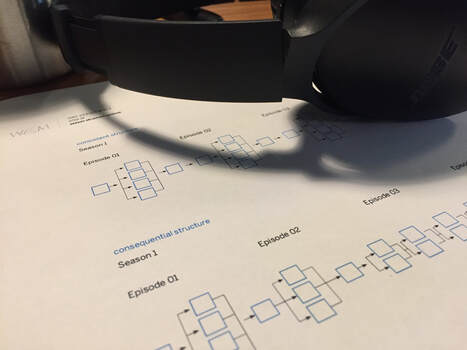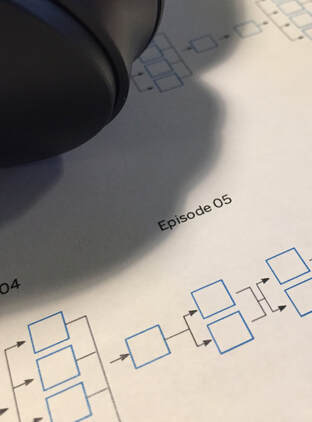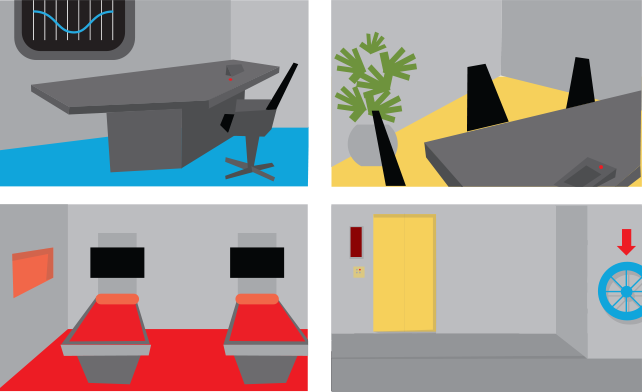|
Last week saw a bit of a milestone for our new project HRO: Adventures of a Humanoid Resources Officer — we completed a working draft of all the branching narrative content for the first “episode” of the game. This first level will serve as our playtesting prototype, so getting this on its feet has been priority for us. Part of drafting the first episode included outlining all six planned episodes in the first season so we could know how they fit together and what we’ll need to include to accomplish all our narrative goals. This process provoked some interesting questions about player choice and what, exactly, makes a choice interesting for a player. One seemingly obvious answer is that interesting choices are choices which have big results. World-shaking, make-or-break, put-it-all-on-the-line, life-or-death types of decisions. I don’t love this answer. If everything is a 10 on the drama scale, nothing seems particularly important. And life isn’t made up of one earth-shattering choice after another. It’s also tough to build genuine human stories out of nothing but technicolor fireworks moments. Traditionally, player choice and the impacts of those choices have either been cosmetic -- ultimately landing the player in a pre-determined spot regardless of choices made -- or consequential in the short-term (usually as side-quests) but leaving the base experience "on rails." We're looking at linking all the episodes in a "season" of HRO modularly so player actions unlock different stories, puzzles and potential interactions across the entire experience. So completing Episode 1 by sending a critical crew member on vacation will give the player a different set of given circumstances at the beginning of Episode 2 than if the player had chosen to forge the navigational records to hide the Captain's crime, for example. One of my favorite things about our last project, Austen Translation, was a conversation I had with a player at the last Boston Festival of Independent Games (BFIG). Austen’s a strategy game dressed up like a dating sim, and this player was making terrible choices and losing — like really obviously losing. After he finished I asked him about it — to make sure our game mechanic wasn’t too obscure or he hadn’t misunderstood the tutorial. He assured me that he knew he was losing, but he was making choices which seemed right for his character. I loved that. His sense of character was so strong that he preferred to play and lose the game in character rather than min-max the strategic options. Those kinds of emotional connections between a player and a game experience are gold, and we’re looking at ways to foster a similar sense of control and consequence for an HRO player. In part, I was thrilled with that Austen player’s response because that’s the way that I tend to play games. I pick my Rimworld survivors based on how much I like them, not necessarily on their chances for success. I’ve played Brittany and Provence in Europa Universalis IV not because I thought I would win with these plucky upstarts, but because I wanted to stick it to France (they think they’re such an Empire… they make me so mad!) I can’t tell you how many ships I trained up for in Eve Online because they looked cool. I’m not against winning. I love to win. But the best win of all is when I can win by doing it my own way -- making my own sometimes unorthodox choices. For the HRO prototype we’re working on making the choices feel consequential for the player, whether they have a dramatic effect on the course of the story events or not. Some will. Some dialogue choices will unlock solutions the player won’t otherwise hear about. Some solutions to each act will remove future options from play, or open up different storylines, or even in some cases, cause characters to die or disappear from the game. Most won’t. If we can get the player to care enough about their humble protagonist, then the choice to suck up to a egomaniacal Captain Spangler or to defy her iron will create stakes high enough to keep them engaged on their journey through the HRO universe. We’re shooting for choices which create emotional connections and maybe, sometimes -- if the player is very brave -- allow them to save the universe.
0 Comments
This may be the time lots of folks are gearing down for lazy, hot, barbecue-filled summer afternoons, but here at Worthing & Moncrieff, we’re hard at work generating all the assets we’ll need for a playable prototype of the entire first episode of “HRO: Adventures of a Humanoid Resources Officer.” As part of that process, I sat down last week to put together the art for the locations which will appear behind the characters when the player is talking with them via video link. In keeping with our television series frame, we’ve been calling them “sets.” Below are some of the original sketches, and farther down then there’s a set of first-draft art to show how they’ll look — in the prototype at least. Part of the challenge is volume — as in quantity. In episode one alone there are something like 16 different locations, mostly aboard the spaceship Endeavor. Of course, like any budget-conscious serial, we’ll be re-using sets (since some locations like the Captain’s office are bound to be seen again). The other big design challenge is the context. The player will only ever see these locations behind a character’s head, so all the visual interest and all the animated bits have to take pace at the extreme left and right of the image, while still being recognizably the places they are supposed to represent. We spent a lot of time looking at the sets the early 1960’s/70’s science fiction series used. Most of these were (not surprisingly) terrible. But there were tricks we could benefit from — the random piece of “technical-looking” panel applied to an otherwise blank wall, for example. And the charm of the randomly blinking light. Some basic animations (like the aforementioned blinking lights) will be added when the sprite sheets for each location are put together. And then there were considerations of the other kind of volume — the kind you get from using depth and perspective technique. Originally, the sets were conceived of as relatively “flat” — really just a decorative horizontal plane slapped behind the character. But by exaggerating and shifting the perspective, we found we could achieve some fun variations which suggest camera placement at odd angles and imply some larger spaces. We also spent some time with unifying all the spaces which appear in the same general locale — like all the ones on the Endeavor, or all the spaces on the enemy ships — through consistent color palettes and furniture styles. We hope you enjoyed this behind-the-curtain glimpse into our process. Stay tuned as we get the prototype on its feet. We’ll share some screen grabs as we go. In the meantime, why aren’t you out there grilling something? It’s officially summer! |
AUTHORWorthing and Moncrieff, LLC is an independent developer of video game stories founded in 2015. ARCHIVES
December 2022
|




 RSS Feed
RSS Feed
